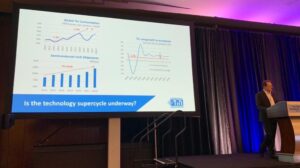The International Tin Association recently hosted the International Tin Conference in Toronto, Canada, 7-9 June 2022, the first major tin event in four years. Despite continued challenges with travel – particularly from Asia – some 160 delegates from across the supply chain attended. After a week of thought-provoking presentations, meetings, and discussion, here are our top three takeaways from the event.
1. Indonesian investment plan requires clarity
 Indonesia is increasingly looking to leverage its natural resources to help grow its economy. Dr Robert Leonard Marbun, senior adviser to the Ministry of Investment, explained that the country was aiming to escape the middle-income trap and become the world’s fifth largest economy by 2045. The government is keen to add value to existing markets, including tin, and would consider driving this via export constraints.
Indonesia is increasingly looking to leverage its natural resources to help grow its economy. Dr Robert Leonard Marbun, senior adviser to the Ministry of Investment, explained that the country was aiming to escape the middle-income trap and become the world’s fifth largest economy by 2045. The government is keen to add value to existing markets, including tin, and would consider driving this via export constraints.
To further this goal, a delegation from the Ministry of Investment met with downstream tin companies around the Conference to explore possible collaboration. Feedback from companies indicated that the idea was potentially interesting and would enable more regional supply chains. This has been a particular focus in recent times due to continued global logistics issues.
However, many felt that the timescales suggested by the Ministry of Investment were optimistic. The government is now considering introducing a policy by the end of 2022, rather than the previous deadline of 2024. Any investment would require a strong business case, which may only become viable in the next few years as regional markets expand.
While most delegates agreed that adding value to Indonesian natural resources was the right move for the country, risks remain for both the local Indonesian and the global markets if regulations regarding export constraints did not fully appreciate tin industry dynamics. However, most felt that more clarity around the exact plans is still required.
2. Rising ESG demands pose new challenges and opportunities for tin
 Increased consumer awareness, investors and regulators are growing the demand for responsibly sourced tin. Sustainable tin is key to achieve the “green economy” and the 2030 UN Sustainable Development Goals.
Increased consumer awareness, investors and regulators are growing the demand for responsibly sourced tin. Sustainable tin is key to achieve the “green economy” and the 2030 UN Sustainable Development Goals.
During the Sustainability sessions, panelists reported that downstream customers are already expanding expectations on transparent ESG reporting, including to the environment. Assent reported that 70% of consumers are willing to pay more for responsible metal, while according to Electronics Watch major public buyers of electric vehicles and ICT equipment are interested in supporting and monitoring responsible production. Supply chain actors highlighted their continued progress and ambitions to achieve Net Zero and socially responsible production.
The tin industry is the leading metal for responsible sourcing, according to the LME, which conditionally recognises Tin Code Standard 7.3 for its recently introduced Responsible Sourcing rules. Through its new LMEpassport scheme, ESG disclosures – including Tin Code reports – are now accessible to the whole supply chain.
These disclosures may even evolve into a “green premium”. The LME will monitor which ESG disclosures are correlated with higher prices via its recent MetalsHub partnership. Panelists across the supply chain agreed that, as the scope and depth of information required increases, fair cost sharing mechanisms – such as these premiums – should be investigated to overcome these challenges.
3. Tin tightness to remain
 While delegates agreed that the tin market was in a relatively calm period, presentations from major solder producer McDermid Alpha and electronics analysts IPC indicated the robust demand fundamentals for tin. ITA’s Dr Jeremy Pearce highlighted the varied opportunities for tin still in research and development.
While delegates agreed that the tin market was in a relatively calm period, presentations from major solder producer McDermid Alpha and electronics analysts IPC indicated the robust demand fundamentals for tin. ITA’s Dr Jeremy Pearce highlighted the varied opportunities for tin still in research and development.
Investment in junior miners is picking up, according to ITA’s market analyst James Willoughby, but development timescales are now at the point where it is almost inevitable that near-term market balances will be in deficit. Presentations from major producers Minsur and PT Timah indicated a focus on longevity, rather than near-term supply improvements. Even with the development of a handful of new mines in the next few years, the market is still highly likely to fall short of tin demand.


